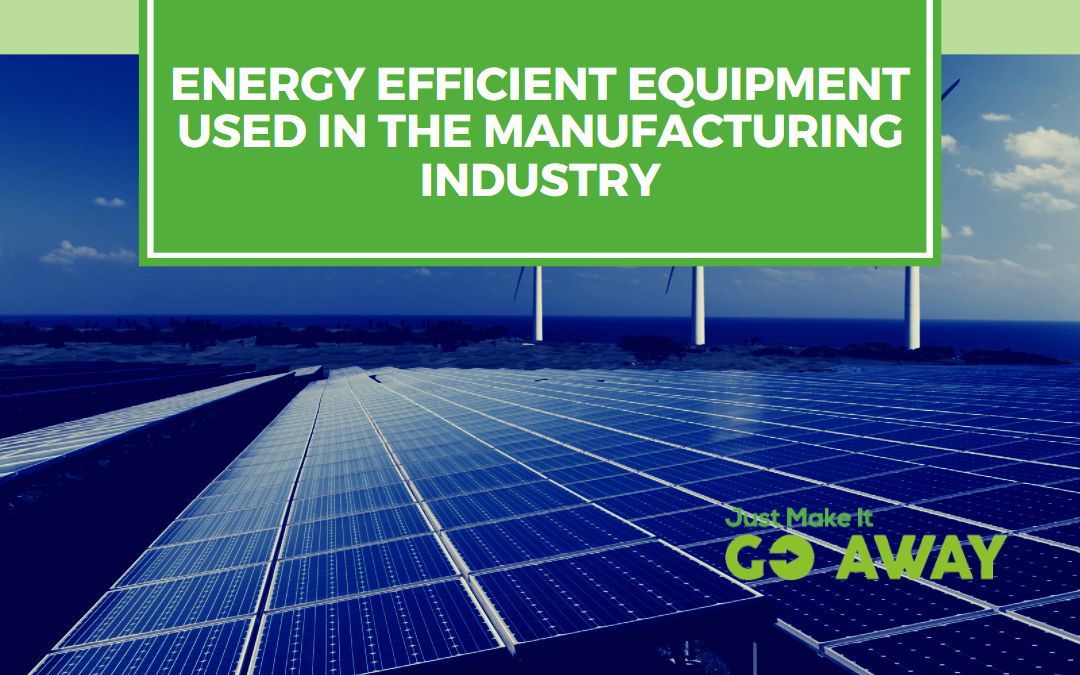Energy efficiency means using less energy to produce the same outcome – something almost all businesses and individuals strive to do on a regular basis. Most businesses focus on buildings and employees when aiming to be more energy efficient. However, in the manufacturing industry, equipment is often one of the most expensive and energy-consuming aspects of production. This article will talk about some of the energy-efficient equipment used in the industry. Whether you work with automotive, textiles, plastics, or food, there are often highly specialized pieces of equipment making the job easier and more precise at the cost of using energy sources such as natural gas, petroleum, electricity, coal, or renewables.
Energy-saving techniques in industries help cut down on utility costs while also reducing resource use and pollution. Despite Covid-19 setbacks to manufacturing and increased domestic energy usage, the U.S. industrial sector accounted for over a third of total U.S. energy consumption in 2020. 77% of this U.S. industrial energy consumption was due to manufacturing practices, over three times more than mining, construction, and agriculture combined. It’s clear that implementing more energy conservation in manufacturing practices can make a large impact on a national scale.
Industrial Energy Conservation Tips
First, establish your baseline energy usage and identify the most energy-consuming aspects of your production as well as any energy leaks. Then, work on correcting these leaks, improving and updating existing equipment, considering energy-efficient, high quality, multitasking new equipment purchases, and reducing energy consumption wherever possible. Although these are broad ideas, manufacturing is a large and diverse industry with no solution that will fit every single type of manufacturer. Instead, we offer several ideas on how to reduce power consumption in the industry that can provide manufacturers with a blueprint of how to get started.
If you’re thinking about taking some steps towards energy efficiency, follow these industrial energy conservation tips and figure out how to make the most efficient energy decisions for your company!
Energy Conservation In Factories
If you’re trying to improve the energy efficiency of your manufacturing operation, the first step is to figure out your baseline energy usage. You can’t objectively implement energy-saving ideas in the industry without knowing where you’re starting from. A thorough energy audit that covers everything from lighting systems and HVAC to machinery and equipment is necessary. These metrics will be important as your business continues to grow, so make sure they’re done correctly the first time around and implement a sustainable way to continue to collect these metrics. If the business is relatively large, consider hiring an independent consultant or using a service such as Energy Star’s Portfolio Manager which benchmarks buildings and provides monthly metrics on energy usage and a tool to collect all this data. When calculating your baseline energy usage, it’s also important as a business to factor costs in as well. Figure out where your main energy costs come from and why.
Once you figure out what the energy you’re consuming is going towards, the next step is identifying any energy leaks. These can be as simple as lights unnecessarily left on or outdated equipment that is using much more energy than a newer upgrade would. Find solutions (there may be multiple) and alternatives to these issues and weigh your options. An easy way to organize initiatives can be sorting them by the impact on energy savings (minor, medium, or major), difficulty to implement (easy, medium, hard), and cost. Starting with the easiest and cheapest initiatives with the most impact can help the whole endeavor seem less daunting and more attainable. However, it’s important to keep in mind that there will always be some loss in energy efficiency; there is never an end of work to be done towards sustainable manufacturing practices.
Energy Conservations In Manufacturing
Small manufacturers that aren’t looking to buy new parts or machines anytime soon can still make improvements to their current arsenal. Manufacturers can make sure they’re maintaining the existing machinery and implementing rigorous checks on all parts of the machine. Just like a car, manufacturing hardware needs regular tune-ups too! Regularly scheduled maintenance can go a long way in increasing lifetime usage. Software updates, lubrication, new replacement parts, and cleaning are just some of the many small improvements that can be made with minimal effort. Having a licensed and skilled technician in charge of this equipment maintenance and prioritizing longevity can benefit any manufacturer, whether the equipment is new or old.
How To Make Machines More Efficient
When buying new equipment, it’s important to consider the efficiency of the machinery. Although newer and fancier machines cost more, it’s often worth the higher upfront cost considering how long that equipment will be in use and how much it is relied upon. The higher cost isn’t just for looks: you pay for energy savings, quality, and better design. Some considerations to make when buying new machinery include:
- Energy Requirements
- Quality
- Multitasking
Energy Requirements
Equipment doesn’t always have to refer to industrial machinery and highly specialized robots. It can be as simple as switching to energy-efficient LED light bulbs that use 70-90% less energy than incandescent light bulbs or automating lights and temperature controls to turn off when a room is not in use. Oftentimes energy-efficient products will pay for themselves in a couple of years or less when considering the energy savings. For instance, an energy-saving electric heat pump water heater costing $700 more than an electric water heater can also save you $3,500 in energy costs throughout its lifetime. Government and utility company rebates and discounts can help offset these higher initial costs to make energy-efficient appliances more affordable.
Quality
Similar to energy-efficient products, higher quality products are often cost-effective as well. Buying better quality machines is an investment into the longevity and reliability of your overall production. You can rely on the machinery to last longer and function more efficiently. Not only that, higher quality equipment often comes with longer and better warranties and better servicing as well. This means that, when your machine needs servicing, your production will not be on pause as long or as frequently as it might be with lower quality machines and parts.
Multitasking
Some equipment is capable of multitasking. Instead of several machines each performing individual tasks, a single multitasking machine often saves space, time, energy, and money in the long run. These pieces of hardware are usually highly specified and may be expensive upfront, requiring time to be engineered and calibrated to their specific use. Although they may be essential and absolutely worth the price for some manufacturers, they may not be relevant for many manufacturers. However, one upside is that, because they are so highly specified, they are also highly customizable. Energy-saving requests upfront can include software that allows the machine to “sleep” or use minimal energy when not in use, automatic software updates, alerts when maintenance is needed, or data-driven strategies to estimate demand to cut down on the excess product. Even potential ways to capture heat and reuse the energy when merging it into your current production line may be integrated into the design.
Ready To Make The Switch To Energy Efficient Equipment?
When switching to new equipment, check with local businesses in the same industry to see if old equipment can be put to good use (and if you can still make some money off of it!). Don’t let the old stuff take up space; instead of paying to recycle old machinery, consider employing the services of a company like Just Make It Go Away that will buy and repurpose your unwanted materials.
Although they go a long way, industrial energy reduction and energy-efficient machinery are not the only methods to reduce your company’s environmental impact. Check out these 7 ways to reduce your carbon footprint, including using additive manufacturing processes or setting higher emission reduction targets. What are some ways you meet your energy efficiency goals?


